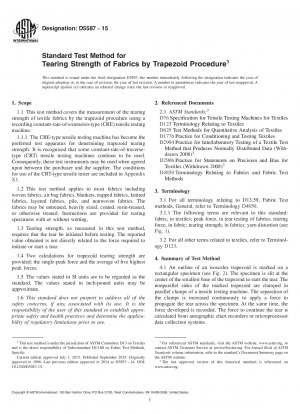ASTM D5587-15
Standard Test Method for Tearing Strength of Fabrics by Trapezoid Procedure
- Standard No.
- ASTM D5587-15
- Release Date
- 2015
- Published By
- American Society for Testing and Materials (ASTM)
- Status
- Replace By
- ASTM D5587-15(2019)
- Latest
- ASTM D5587-15(2024)
- Scope
5.1 This test method is considered satisfactory for acceptance testing of commercial shipments because current estimates of between-laboratory precision are acceptable, and this test method is used extensively in the trade for acceptance testing.
5.2 If there are differences of practical significance between test results for two laboratories (or more), comparative test should be performed to determine if there is a statistical bias between them, using competent statistical assistance. As a minimum, use the samples for such a comparative test that are as homogeneous as possible, drawn from the same lot of material as the samples that resulted in disparate results during initial testing. Randomly assign the samples in equal numbers to each laboratory. The test results from the laboratories involved should be compared using a statistical test for unpaired data, at a probability level chosen prior to the testing series. If bias is found, either its cause must be found and corrected, or future test results for that material must be adjusted in consideration of the known bias.
5.3 The trapezoid tear produces tension along a reasonably defined course such that the tear propagates across the width of the specimen. It is useful for estimating the relative tear resistance of different fabrics or different directions in the same fabric.
5.4 Depending on the nature of the specimen, the data recording devices will show the tearing force in the form of a peak or peaks. The highest peaks appear to reflect the strength of the yarn components, individually or in combination, needed to stop a tear in fabrics of the same construction. The valleys recorded between the peaks have no specific significance. The minimum tearing force, however, is indicated to be above the lowest valleys.
5.5 Most textile fabrics can be tested by this test method. Some modification of clamping techniques may be necessary for a given fabric, depending upon its structure. Strong fabrics or fabrics made from glass fibers require special adaptation to prevent them from slipping in the clamps or being damaged as a result of being gripped in the clamps. In some cases, due to fabric constructions, individual yarns may not rupture but show a high peak and yarn distortion within the test specimen. Wherever possible, this shall be prevented. If you have tried all of these steps and yarn distortion still occurs, this must be included in the report.
5.6 The CRE-type is the preferred tensile testing machine. This test method allows the use of the CRT-type tensile machine when agreed upon between the purchaser and the supplier. There may be no overall correlation, however, between the results obtained with the CRT-type machine and the CRE-type machine. Consequently, these two tensile testers cannot be used interchangeably unless the degree of quantitative correlation has been established between the purchaser and the supplier. In any event, the CRE-type machine shall prevail.
1.1 This test method covers the measurement of the tearing strength of textile fabrics by the trapezoid procedure using a recording constant-rate-of-extension-type (CRE) tensile testing machine.
1.1.1 The CRE-type te......
ASTM D5587-15 Referenced Document
- ASTM D123 Standard Terminology Relating to Textiles
- ASTM D1776 Standard Practice for Conditioning and Testing Textiles
- ASTM D2904 Standard Practice for Interlaboratory Testing of a Textile Test Method that Produces Normally Distributed Data
- ASTM D2906 Standard Practice for Statements on Precision and Bias for Textiles
- ASTM D4850 Standard Terminology Relating to Fabrics and Fabric Test Methods
- ASTM D629 Standard Test Methods for Quantitative Analysis of Textiles
- ASTM D76 Standard Specification for Tensile Testing Machines for Textiles
ASTM D5587-15 history
- 2024 ASTM D5587-15(2024) Standard Test Method for Tearing Strength of Fabrics by Trapezoid Procedure
- 2019 ASTM D5587-15(2019) Standard Test Method for Tearing Strength of Fabrics by Trapezoid Procedure
- 2015 ASTM D5587-15 Standard Test Method for Tearing Strength of Fabrics by Trapezoid Procedure
- 2014 ASTM D5587-14 Standard Test Method for Tearing Strength of Fabrics by Trapezoid Procedure
- 2008 ASTM D5587-08 Standard Test Method for Tearing Strength of Fabrics by Trapezoid Procedure
- 2007 ASTM D5587-07ae1 Standard Test Method for Tearing Strength of Fabrics by Trapezoid Procedure
- 2007 ASTM D5587-07a Standard Test Method for Tearing Strength of Fabrics by Trapezoid Procedure
- 2007 ASTM D5587-07 Standard Test Method for Tearing Strength of Fabrics by Trapezoid Procedure
- 2005 ASTM D5587-05 Standard Test Method for Tearing Strength of Fabrics by Trapezoid Procedure
- 2003 ASTM D5587-03 Standard Test Method for Tearing Strength of Fabrics by Trapezoid Procedure
- 1996 ASTM D5587-96(2003) Standard Test Method for Tearing Strength of Fabrics by Trapezoid Procedure
- 1996 ASTM D5587-96 Standard Test Method for Tearing Strength of Fabrics by Trapezoid Procedure

Copyright ©2024 All Rights Reserved